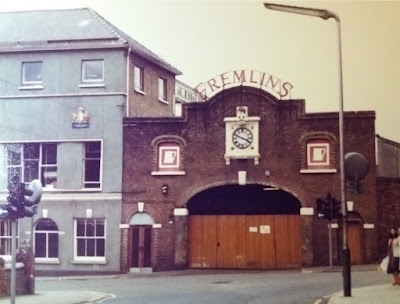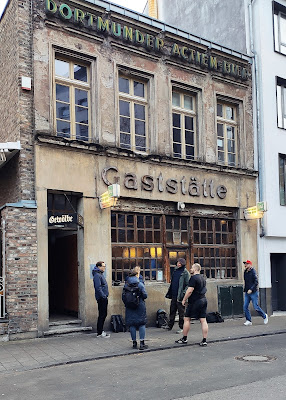I was having a sort out earlier this morning, when I
stumbled upon a pile of notes that I’d made in relation to the
Rhineland city
of
Cologne. As you're no doubt aware, last month I published a quite lengthy piece
consisting of reflections, looking back over my many visits to the city. I
tried to make the post as comprehensive as possible but obviously couldn't include
everything. Now, after looking back over these notes, it’s evident there are quite
a few gaps, and so, in the interests of completeness, I've added them in here.
But will this be the final word on
Cologne? A city I have visited on eight
separate occasions, which is more than any other overseas destinations. The
answer is I don't know, although it certainly is for the time being, so sit back and
relax as I describe a few more of
Cologne’s beery gems.
Brauerei Päffgen is a place that is well-known to beer
lovers; not only is its wonderfully hoppy
Kölsch brewed at the rear of the
premises, but it is also dispensed from wooden casks. A former school friend
had taken me to
Päffgen during my first visit to
Cologne, way back in
1975. My
friend was living and working in the city as part of the language degree he was
taking. I was also a student, but at the time was travelling around
Europe, by
train, on an
Inter-Rail ticket with a friend from university. Even back then I
had a reputation for enjoying good beer so my host, knowing this fact, had
taken me to
Päffgen as he knew I would be impressed.
I didn’t plan on waiting
34 years before returning, but in
2009, on an evening out with a few colleagues, whilst attending the
Cologne
International Dental Show, I was finally able to make that return visit to
Päffgen. With a sense of eager anticipation, my colleagues and I pushed open the
door, and found ourselves in a central corridor with a small room leading off
to the left, and a much larger one to the right. We opted for the latter and
were soon seated at one of the many tables in the wood-panelled room. On the
way in we noticed two up-ended wooden casks, tapped and ready for serving.
We ordered a
Kölsch each and were pleasantly surprised by
its hoppy flavour. I had a look round the rest of the pub to see if it would
bring back any memories. I recognised the large back room at the end of the
corridor as being the place where, on a damp July evening, my friend and I had
sat enjoying several glasses of
Päffgen Kölsch. It was great to be back, even
if the memories were rather vague but sadly, as mentioned previously, I haven’t
been back since then, despite several attempts during subsequent visits to
IDS.
In
May 2017, I made a non-work-related visit to
Cologne,
along with son
Matthew. We were part of a group of beer enthusiasts drawn
mainly from
Maidstone CAMRA, plus a few neighbouring branches. Our visit to
Cologne was a one-day interlude, that occurred during a stay in the
neighbouring
Rhineland city of
Düsseldorf – basically what Americans
would call a
“side-trip.” The transit time between the two cities is around
35
minutes, so it’s a journey that’s well worth making.
We were in
Cologne for a look around, and also to
have a tour around a typical
Kölsch brewery, in the guise of
Brauerei
Sünner. Our visit was not scheduled until later in the afternoon, so
this gave us plenty of time for a look around
Cologne and also to sample some
Kölsch.
We decided to make for
Brauerei
zur Malzmühle at
Heumarkt; an old established former brewpub at the far end of the
Alter
Markt. This was a pub I had never managed to get to on previous visits to the
city, so I was quite pleased with the opportunity to go there this time around.
Housed in a rather functional-looking building,
replacing the original structure, which was destroyed in World War II,
Malzmühle was every bit the traditional German beer house on the inside.
With high ceilings and plenty of wood panelling, we made for the two tables at
the far end of the room. One of the thoughtful waiters came over and fixed a “bridge”
in between the two, thereby joining them and enabling us to all sit together.
Malzmühle
Kölsch was quite a bitter variant on the style. Being
slightly away from the main tourist areas, Brauerei zur Malzmühle was very much a
local’s pub, but we were nevertheless made very welcome. (I think the staff
were glad of our presence during what seemed a slack period).
Our day in
Cologne concluded with the aforementioned
visit to
Brauerei Sünner, a traditional brewery on the other side of the
River Rhine, and one where the
Kölsch style of beer is said to have
originated. I’m rather surprised to discover, that I didn’t write anything about
the brewery tour, at the time, but despite an extensive search cannot find
anything. I did take quite a few photos, though, so you will have to make do with
those.
After our tour around the brewery concluded, we enjoyed an excellent
evening meal, served in the small beer garden attached to the brewery. This
area open to local residents, as well as visitors to the brewery, as evidenced
by the photos, and if you look carefully, you will notice a small keg of
Kölsch
on one of the tables. A nice idea that saves on trips to the bar or trying to
attract the attention of the waiting staff.
One city centre
Kölsch outlet that I visited, during one of my
first business trips to
Cologne, was
Pfaffen.
At the time, this was the only outlet for the beer of the same name, and story
behind this establishment dates back to a fall out between owner,
Max Päffgen,
and other members of the
Päffgen family. This led to
Max starting a brewery of
his own. I wrote at the time that the
Pfaffen Kölsch served at
Max’s pub, was
probably the best version of the style I tasted during my stay in
Cologne. It
was so good that I stayed for several more glasses.
The
Pfaffen tavern is
a long, narrow building featuring some attractive carved, light-coloured woodwork
and also some interesting contemporary stained glass. Regrettably, I haven’t
been back since, but with beer that good I brought my colleagues there on our last
night in the city, and they were well impressed. The beer was served direct
from wooden casks, and such was the demand for this excellent
Kölsch that we
witnessed the cask being changed twice in less than an hour and saw the row of
empties stacked up in the corridor.
I’m not sure as to when I first came across
Schreckenskammer-Kölsch.
It must have been prior to my penultimate visit to
Cologne, which was in
2019. This was at a time when I believed I had
drunk
virtually every Kölsch available in the city, so stumbling upon
Schreckenskammer
came as something of a surprise. I bought a
500ml bottle during that
2019
trip but was determined to track down the
Schreckenskammer
pub on my next visit to
Cologne, little thinking that, thanks to
Covid,
the trip wouldn’t be for another four years!
Situated to the north-west of
Cologne’s imposing main
rail station, or
Hauptbahnhof, the pub
was quite easy to find,
particularly with the assistance of
Google Maps, on my
Smart Phone. The
distinctive looking church tower of
St Ursula, acted as my guide as I drew near to the pub. With
the original
Schreckenskammer beer house destroyed
by
Allied bombing, in
1943, today’s
pub is a modern building,
which dates from the
1960’s. It is still quite an attractive looking building,
which overlooks a paved area at the entrance to the church. Pleased with myself
for having found the place, I gingerly pushed the door open and stepped inside.
There was a small room over to the left, with its own
serving counter, complete with some casks of beer, in full view of the
customers. There was a handful of customers present, plus a member of staff
behind the counter. It looked very much like a
“private
bar,” so I headed,
instead, for the larger, and more spacious room to the right. It was laid out
with plenty of tables and chairs, but very little in the way of empty places,
as most seemed occupied with diners.
I
sat myself down at the end of one such table, with my back to the window. I do
this in most pubs, as I like to see what’s going on, rather than sit with my
back to the action.
When the waiter, or Kobe, passed, by with his tray of glasses, he uttered
the word, “Kölsch,” and almost without waiting for an answer,
placed a full glass on the table in front of me, whilst at the same time
marking a fresh beer mat, with a tick. The beer was served in a badged glass –
as per the photo and was rather good, with a deep golden colour
and plenty of body. The pub itself was buzzing, with a lively mix of customers,
spanning several different age groups. I got the impression that most of them
were local, drawn from the nearby flats.
Finding
Schreckenskammer left just one final, classic
Cologne pub to tick off my list, and that outlet was the legendary
Gaststätte
Lommerzheim, which I visited on my final evening in
Cologne. Known locally
as
Lommi’s, this establishment is a
“must visit” Cologne institution,
and one of those pubs you feel privileged to have experienced. Recommended by a
wide assortment of different beer writers, including
Matt from
Stockport, Retired
Martin, and
Rob Sterowski, but still far enough off the beaten track to have
escaped the notice of the more usual suspects,
Lommerzheim is in a class
of its own.
Described as a throwback to a bygone era, Lommi’s is a proper
community local, catering to a wide age groups and a diverse range of
customers. As well as serving one of the best glasses of Kölsch in Cologne - Päffgen, naturally, dispensed
from a wooden cask behind the bar counter, the food looks really inviting as
well, that’s if you can find space at table where you can sit down and get
stuck in. On my visit, shortly after 6pm on a Thursday evening, the place was packed
with people were enjoying themselves, either in small groups or conversing with
friends and neighbours.
If you want to learn more, then click on
the link here, but don’t
just take my word for it, add
Gaststätte Lommerzheim to your beer-bucket
list, or make it an essential part of any visit to
Cologne and the
Rhineland,
(there are some classic pubs in
Düsseldorf as well, and like
Cologne, the
city has its own unique style of beer). If these accounts haven’t whetted your appetite,
then I don’t know what will, but I do know I have spent some very happy times in
this part of
Germany, drank some truly amazing beers and enjoyed them in some
equally wonderful pubs.










































